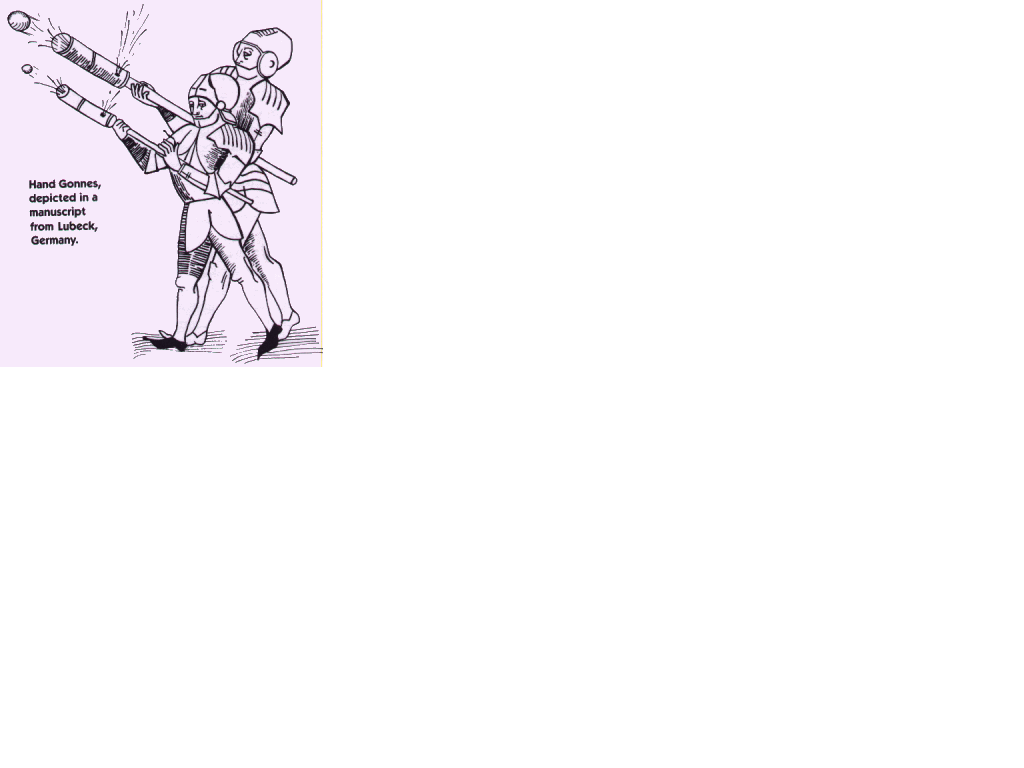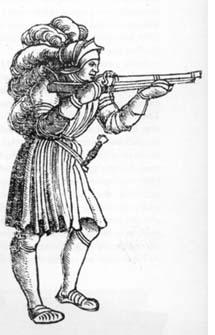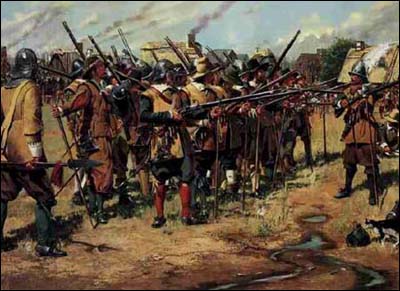
Accuracy was poor and the barrel fouled after a few shots and required cleaning before further use. Maximum range was about 50 yards. To put this in perspective, remember short bows had a maximum range of 150 yards.
| CAMPAIGN 4 - EXPLORING THE UNKNOWN | |
| RANGED WEAPONRY: FIREARMS |
|
Purpose The purpose of this page is to explain the rationale behind the ai and mi infantry unit types. Introduction The purpose of ranged weapons is to kill the enemy before they get close enough to melee. In the 1300s gunpowder artillery (various sized bombards) was developed to do this, but weighed hundreds of pounds or more and rested on wooden frames without wheels. Once such artillery had been in use for a while, it became obvious it was too ponderous to react to sudden changes in battlefield fortune. Experimentation began on a smaller-caliber weapon with greater mobility. NOTE: all units discussed require a Gunnery QR of at least 1, i.e. at least some working knowledge of gunpowder weapons. Firearms This experimentation (investing in Gunnery QR) led to the development in the late 1300s of the handgonne (aka Hand Gonne). |

|
As shown, the first personal firearms were a miniature cast
bronze or cast iron gun barrel attached to a wooden stock by iron bands. Powder and
shot were muzzle-loaded and more
powder sprinkled into the vent-hole at the rear end. The weapon was held by the
handgonner under one
arm while the other arm's hand touched the vent hole with
something actively burning. The handgonne then discharged, hopefully towards
the enemy.
Accuracy was poor and the barrel fouled after a few shots and required cleaning before further use. Maximum range was about 50 yards. To put this in perspective, remember short bows had a maximum range of 150 yards. |

|
Unlike the handgonne, the arquebus had a curved stock which fit to the shoulder, making the weapon steadier. A smaller caliber and longer barrel improved range to 100 - 150 yards, same as the short bow. The arquebusiers made use of another early 1400s invention, the slow match. A slow match was a piece of cord soaked in saltpeter that when lit slowly smouldered. It was carried on a special holder (linstock). When fire was needed for shooting, a few swings would fan the slow match to brightness and it would be touched to the vent-hole. This was more efficient than having to stop and build a fire before each shot. In the mid-1450s came the innovation of the matchlock. An armlike device on the side of the arquebus held a slow match and pressed it against the vent-hole when the trigger was pulled. This was much more efficient for an arquebusier than having to manually use the slow match, and allowed both hands for aiming the matchlock arquebus, thereby improving accuracy. |
| Unit Type | Cost (Gp, Nfp) |
Strength (Cbt / Seige) |
Max Range (Yards) |
Additional Capabilites (Compared to Regular Infantry) |
| Infantry ( i ) | 150 | n/a | ||
| Arquebus Inf ( ai ) | 150 | first-round combat bonus vs. gunpowder-unfamiliar enemy |
| GM NOTES:
A few changes have been made to the standard Renaissance UBC, so be alert if you have a Renaissance nation in another campaign. In the standard Renaissance UBC, infantry combat strength increases by 50% simply by virtue of reaching TL 8. I believe this increase simulated the addition of arquebusiers among the infantry. Since I felt it more historically accurate to have separate arquebus infantry, in Lords4 those increased stats were assigned to the new ai units, and the infantry kept its pre-Renaissance strength along with its pre-Renaissance weapons mix. The other change was to slow down HEI from 8 to 7AP. I don't believe men in heavy armor and carrying pikes or polearms could march faster than regular infantry in hauberks and carrying swords. Maybe as fast due to being elite, but not faster. |

|
It was a major
improvement, firing larger shot (almost 2.5 oz vs. 1 oz for the arquebus) with greater
hitting power. Range improved to ~ 200 yards. It was much heavier than the arquebus and
so the musketeer carried a metal forked pole in which to
rest the musket while aiming.
The slow match held by the matchlock still left a lot to be desired, having to be replaced often. In the later 1500s came the innovation of the snaphance. A spring-loaded device on the side of the musket held a flint which |
| Unit Type | Cost (Gp, Nfp) |
Strength (Cbt / Seige) |
Max Range (Yards) |
Additional Capabilites (Compared to Regular Infantry) |
| Infantry ( i ) | 150 | n/a | ||
| Arquebus Inf ( ai ) | 150 | first-round combat bonus vs. gunpowder-unfamiliar enemy |
||
| Musket Inf ( mi ) | 200 | first-round combat bonus vs. gunpowder-unfamiliar enemy; fires before regular combat |
Version 2.1 - February 2009